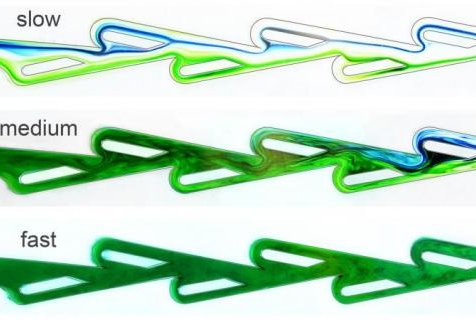As flow rates increase, the Tesla valve begins to more effectively block reverse flows.
Photo by NYU's Applied Mathematics Laboratory
May 17 (UPI) -- Scientists have discovered new potential applications for a valve invented and patented by famed engineer Nikola Tesla 100 years ago.
Researchers conducted a variety of tests using the valvular conduit, or Tesla valve. The results revealed the valve to be much more capable than Tesla assumed.
According to the experimental results, published Monday in the journal Nature Communications, the device could be used to harness the vibrational frequencies in engines and other turbines to pump fuel, coolants, lubricants and other gases and liquids.
Tesla developed the novel valve -- a series of interconnected, but asymmetric, tear-shaped loops -- to move fluid in a single direction without any moving parts.
Tests showed the valve to be quite capable of directing forward flows, but less adept at reversing the flow.
However, scientists hypothesized that the valve's shortcomings might actually make the device useful in situations where flow rates must be precisely controlled.
In a series of experiments, researchers measured the valve's resistance to flows in both directions. The results showed the valve offers little resistance at slow flow rates, but at faster flow rates -- above a certain threshold -- the valve begins to resist reverse flows.
The valve works a bit like a switch, turning on once flow rates increase.
"Crucially, this turn-on comes with the generation of turbulent flows in the reverse direction, which 'plug' the pipe with vortices and disrupting currents," senior author Leif Ristroph said in a press release.
"Moreover, the turbulence appears at far lower flow rates than have ever previously been observed for pipes of more standard shapes -- up to 20 times lower speed than conventional turbulence in a cylindrical pipe or tube. This shows the power it has to control flows, which could be used in many applications," said Ristroph, an associate professor in New York University's Courant Institute of Mathematical Sciences.
Experiments also showed the valve helps smooth out intermittent or pulsing flows, not unlike the way AC-DC converters turn alternating currents into direct currents.
"We think this is what Tesla had in mind for the device, since he was thinking about analogous operations with electrical currents," said Ristroph. "He in fact is most famous for inventing the AC motor as well as an AC-DC converter."
The researchers estimate the Tesla valve could replace the more conventional check valve, which relies on moving parts that wear out and fail after extended use.
"Our findings indicate that its valving action is best at high frequencies," researchers wrote in their paper. "This motivates the specific application in which the vibrations intrinsic to all forms of machinery are harnessed to pump coolants, fuels, lubricants, or other fluids needed for proper operation."















